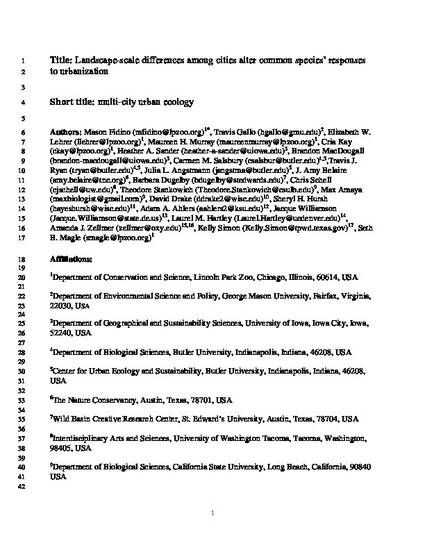
Understanding how biodiversity responds to urbanization is challenging, due in part to the single-city focus of most urban ecological research. Here, we delineate continent-scale patterns in urban species assemblages by leveraging data from a multi-city camera trap survey and quantify how differences in greenspace availability and average housing density among 10 North American cities relate to the distribution of eight widespread North American mammals. To do so, we deployed camera traps at 569 sites across these ten cities between 18 June and 14 August. Most data came from 2017, though some cities contributed 2016 or 2018 data if it was available. We found that the magnitude and direction of most species' responses to urbanization within a city were associated with landscape-scale differences among cities. For example, eastern gray squirrel (Sciurus carolinensis), fox squirrel (Sciurus niger), and red fox (Vulpes vulpes) responses to urbanization changed from negative to positive once the proportion of green space within a city was >~20%. Likewise, raccoon (Procyon lotor) and Virginia opossum (Didelphis virginiana) responses to urbanization changed from positive to negative once the average housing density of a city exceeded about 700 housing units/km2. We also found that local species richness within cities consistently declined with urbanization in only the more densely developed cities (>~700 housing units/km2). Given our results, it may therefore be possible to design cities to better support biodiversity and reduce the negative influence of urbanization on wildlife by, for example, increasing the amount of green space within a city. Additionally, it may be most important for densely populated cities to find innovative solutions to bolster wildlife resilience because they were the most likely to observe diversity losses of common urban species.
This is a peer reviewed accepted version of the following article:
Fidino, M., Gallo, T., Lehrer, E. W., Murray, M. H., Kay, C. A. M., Sander, H. A., MacDougall, B., Salsbury, C. M., Ryan, T. J., Angstmann, J. L., Belaire, J. A., Dugelby, B., Schell, C. J., Stankowich, T., Amaya, M., Drake, D., Hursh, S. H., Ahlers, A. A., Williamson, J., Hartley, L. M., Zellmer, A. J., Simon, K., and Magle, S. B.. 2021. Landscape-scale differences among cities alter common species’ responses to urbanization. Ecological Applications 31(2):e02253. 10.1002/eap.2253.
The published version of this article can be found at: Ecological Applications. This article may be used for non-commercial purposes in accordance With Wiley Terms and Conditions for self-archiving.
Available at: http://works.bepress.com/travis_ryan/40/
